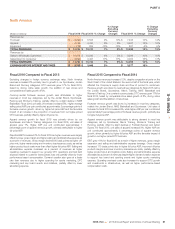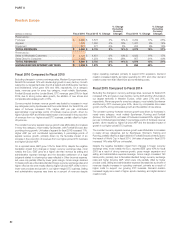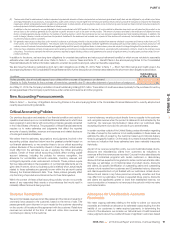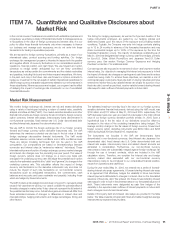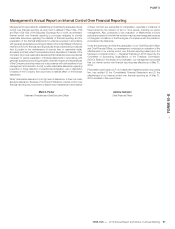Nike 2016 Annual Report Download - page 36
Download and view the complete annual report
Please find page 36 of the 2016 Nike annual report below. You can navigate through the pages in the report by either clicking on the pages listed below, or by using the keyword search tool below to find specific information within the annual report.
PART II
Refer to Note 6 — Fair Value Measurements and Note 16 — Risk
Management and Derivatives in the accompanying Notes to the Consolidated
Financial Statements for additional description of how the above financial
instruments are valued and recorded as well as the fair value of outstanding
derivatives at each reported period end.
Translational Exposures
Many of our foreign subsidiaries operate in functional currencies other than
the U.S. Dollar. Fluctuations in currency exchange rates create volatility in our
reported results as we are required to translate the balance sheets,
operational results and cash flows of these subsidiaries into U.S. Dollars for
consolidated reporting. The translation of foreign subsidiaries’ non-U.S. Dollar
denominated balance sheets into U.S. Dollars for consolidated reporting
results in a cumulative translation adjustment to Accumulated other
comprehensive income within the Consolidated Statements of Shareholders’
Equity. In the translation of our Consolidated Statements of Income, a weaker
U.S. Dollar in relation to foreign functional currencies benefits our consolidated
earnings whereas a stronger U.S. Dollar reduces our consolidated earnings.
The impact of foreign exchange rate fluctuations on the translation of our
consolidated Revenues was a detriment of approximately $1,985 million and
$1,171 million for the years ended May 31, 2016 and 2015, respectively. The
impact of foreign exchange rate fluctuations on the translation of our Income
before income taxes was a detriment of approximately $449 million and $221
million for the years ended May 31, 2016 and 2015, respectively.
Managing Translational Exposures
To minimize the impact of translating foreign currency denominated revenues
and expenses into U.S. Dollars for consolidated reporting, certain foreign
subsidiaries use excess cash to purchase U.S. Dollar denominated available-
for-sale investments. The variable future cash flows associated with the
purchase and subsequent sale of these U.S. Dollar denominated securities at
non-U.S. Dollar functional currency subsidiaries creates a foreign currency
exposure that qualifies for hedge accounting under the accounting standards
for derivatives and hedging. We utilize forward contracts and/or options to
mitigate the variability of the forecasted future purchases and sales of these
U.S. Dollar investments. The combination of the purchase and sale of the
U.S. Dollar investment and the hedging instrument has the effect of partially
offsetting the year-over-year foreign currency translation impact on net
earnings in the period the investments are sold. Hedges of available-for-sale
investments are accounted for as cash flow hedges.
Refer to Note 6 — Fair Value Measurements and Note 16 — Risk
Management and Derivatives in the accompanying Notes to the Consolidated
Financial Statements for additional description of how the above financial
instruments are valued and recorded as well as the fair value of outstanding
derivatives at each reported period end.
We estimate the combination of translation of foreign currency-denominated
profits from our international businesses and the year-over-year change in
foreign currency related gains and losses included in Other (income) expense,
net had an unfavorable impact of approximately $423 million and $73 million
on our Income before income taxes for the years ended May 31, 2016 and
2015, respectively.
Net Investments in Foreign Subsidiaries
We are also exposed to the impact of foreign exchange fluctuations on our
investments in wholly-owned foreign subsidiaries denominated in a currency
other than the U.S. Dollar, which could adversely impact the U.S. Dollar value
of these investments and therefore the value of future repatriated earnings.
We have, in the past, hedged and may, in the future, hedge net investment
positions in certain foreign subsidiaries to mitigate the effects of foreign
exchange fluctuations on these net investments. These hedges are
accounted for in accordance with the accounting standards for net
investment hedges. There were no outstanding net investment hedges as of
May 31, 2016 and 2015. There were no cash flows from net investment
hedge settlements for the years ended May 31, 2016 and 2015.
Liquidity and Capital Resources
Cash Flow Activity
Cash provided by operations was $3,096 million for fiscal 2016 compared to
$4,680 million for fiscal 2015. Our primary source of operating cash flow for
fiscal 2016 was Net income of $3,760 million. Our fiscal 2016 change in
working capital was a net cash outflow of $1,580 million as compared to a net
cash inflow of $256 million for fiscal 2015. The change in working capital was
primarily due to a net decrease in the amount of cash collateral received as a
result of hedging activities (refer to the Credit Risk section of Note 16 — Risk
Management and Derivatives for additional detail). For fiscal 2016, cash
collateral received from counterparties declined $863 million as compared to
an increase in collateral received from counterparties of $968 million for fiscal
2015.
Cash used by investing activities was $1,034 million for fiscal 2016, compared
to a $175 million use of cash for fiscal 2015. The primary driver of the increase
in Cash used by investing activities was the net change in short-term
investments (including sales, maturities and purchases) from net sales/
maturities to net purchases. In fiscal 2016, there were $57 million of net
purchases of short-term investments compared to $935 million of net sales/
maturities of short-term investments in the same period of fiscal 2015.
Additions to property, plant and equipment were $1,143 million for fiscal 2016
as compared to $963 million for fiscal 2015. The increase in Additions to
property, plant and equipment resulted from continued investments in
infrastructure to support current and future growth, primarily relating to supply
chain and corporate initiatives, as well as expansion of our DTC operations.
In fiscal 2017, we plan to continue investing in our infrastructure to support
future growth, as well as expand our digital capabilities. We anticipate
investing approximately 4% of revenue, a portion of which will be used for the
continued expansion of our corporate facilities, new DTC stores and digital
capabilities.
Cash used by financing activities was $2,671 million for fiscal 2016 compared
to $2,790 million for fiscal 2015, a decrease of $119 million, as increases in
share repurchases and dividends were more than offset by the receipt of
$981 million in net proceeds from the issuance of long-term debt in October
2015.
In fiscal 2016, we purchased 55.4 million shares of NIKE’s Class B Common
Stock for $3,238 million (an average price of $58.44). During the third quarter
of fiscal 2016, we concluded the Company’s four-year, $8 billion share
repurchase program approved by our Board of Directors in September 2012.
Under this program the Company purchased a total of 197.1 million shares at
a cost of $8 billion (an average price of $40.58 per share). Following the
completion of this program, the Company began purchases under a four-
year, $12 billion program approved by our Board of Directors in November
2015. Of the total 55.4 million shares repurchased in fiscal 2016, 20.1 million
shares were purchased under this new program at a cost of approximately
$1,189 million (an average price of $59.21 per share). We continue to expect
funding of share repurchases will come from operating cash flow, excess
cash and/or debt. The timing and the amount of shares purchased will be
dictated by our capital needs and stock market conditions.
NIKE, INC. 2016 Annual Report and Notice of Annual Meeting 89
FORM 10-K




